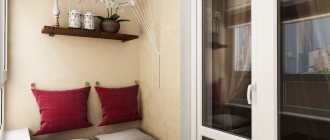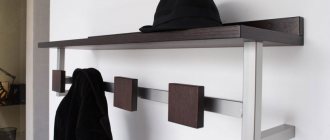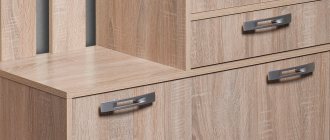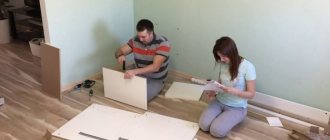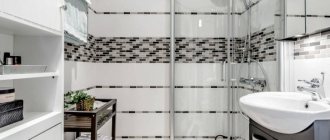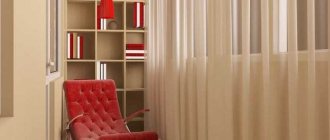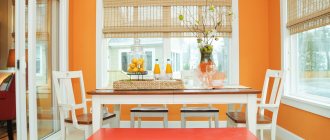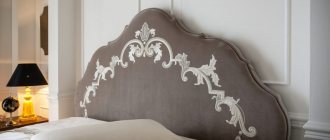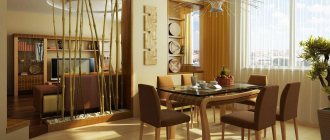0
14776
It is not always possible to purchase new furniture, because new interior items are expensive. In such cases, you can transform old cabinets, chests of drawers and other products yourself. In addition, decorating furniture with your own hands will allow you to avoid unnecessary financial costs and decorate the room with original models.
Self-adhesive film
The simplest option, which does not require much time or financial investment, is to cover the furniture with self-adhesive tape.
In the assortment of construction stores, the bulk of the models repeat the pattern of wood in various shades, and there are also floral or abstract ornaments.
In order to transform furniture you will need:
- self-adhesive;
- metal spatula;
- plastic spatula;
- degreaser.
Work process
First, you need to remove the layer of old paint using a metal spatula so that the film lays flat, then treat the surface with a degreaser; without this, the self-adhesive may wrinkle over time.
After drying, stick the film, gradually separating the bottom layer from the adhesive base, while simultaneously smoothing the surface with a spatula; it is better to use a plastic one; it is much less likely to scratch the decorative layer of the film.
We recommend reading:
Volumetric decoupage is the best master class for beginners. Step-by-step instructions and all the features of the decoupage technique (100 photos + video tutorial)Paper for decoupage - an overview of all types. Instructions on how to choose and use the right material using the decoupage technique (120 photos + video)
- DIY furniture decoupage: TOP-150 photos of original ideas. Step-by-step instructions + master class with examples
The main advantage of this method is that it does not require long drying, there is no smell of paint or varnish, and after updating the furniture can be immediately used for its intended purpose in the living room.
The main disadvantage is that in order to stick the self-adhesive evenly, skill is required. It’s rare for anyone to succeed the first time, so it’s best to practice on an invisible area first.
Ready-made products
At a hardware store you can purchase stencils and stickers for furniture decor. Artistic talent is not given to everyone, so this solution is ideal for those who want to improve their furniture as quickly as possible.
Using a stencil and paint, the damaged area can be quickly masked, or the damage can be hidden with a sticker. The advantages of this method are speed. You don't need any experience to decorate furniture this way. It will suit everyone.
The downside is that without proper fastening, such decor is only a temporary measure if it is not fixed with varnish.
We recommend reading:
Do-it-yourself decoupage of a cutting board: a master class for beginners on how to make an original decoration (instructions + photos)Children's room decor: a review of interesting solutions + step-by-step instructions on how to make beautiful decor in a nursery with your own hands (130 photos of new designs)
In addition, it is not so easy to find from the assortment of ready-made solutions something that is suitable in size, color and texture at the same time.
Stencils
This is a fairly interesting and simple update option. You should also choose paint.
Similar to the previous option, the furniture should be prepared. The advantage of using stencils is the ability to hide unevenness, thereby enlivening and improving the interior of the room.
- DIY cornice: a detailed description of how to design and decorate a stylish interior element (80 photos)
DIY folding chair: 110 photos, drawings, diagrams and sketches of convenient and easy options for creating portable chairs
- Do-it-yourself pouf: step-by-step instructions on how to build a stylish and original interior element with your own hands (105 photos)
You need to decide on a location, apply a stencil and spray paint. After this, you need to apply several layers of varnish, so the surface you are creating will become more uniform.
Note! If you are decorating wooden furniture, then the best choice for you will be acrylic paint. For beginners, car or spray paint is suitable.
You can make stencils yourself. To do this, you need to draw a pattern, then cut out the corresponding holes. This blank is suitable for decorating any furniture.
Painting
A somewhat more labor-intensive, but more reliable method of decoration. In order to paint a piece of furniture, you will need to remove the old paint layer using sandpaper, degrease and prime the surfaces. After the primer has dried, the furniture is coated with paint.
You can choose regular, glossy or matte, you can pay attention to textured paints such as hammer or crackle. After drying, hammer paint will give the surface a voluminous relief, and crackle, when dry, will form interesting cracks.
To consolidate the result, the dried paint must be coated with a layer of furniture varnish.
The advantage of this method of decoration is that after painting the furniture will retain its attractive appearance for a long time.
We recommend reading:
Door decor - 130 photos of exclusive ideas and options. Instructions on how to make decor with your own hands (video + master class)Beautiful DIY kitchen decor - a review of the best ideas. Original and modern design TOP-150 photos
DIY wall decor - a review of the best and original ideas. 135 photos of ready-made solutions, all implementation features + instructions
The downside is that each stage requires complete drying, which takes quite a lot of time. You should also not bring furniture into the room until the varnish is completely dry, otherwise it will be very difficult to get rid of the smell.
New from old
Very often, old furniture eventually moves to a landfill or to a country house, although it can be given a second life, and this item will last another ten years. The peculiarity of old pieces of furniture is that they are of much higher quality than what manufacturers often offer nowadays. If you add to this a unique design, you get an excellent item that will be truly valuable. It's very easy to transform your grandmother's old chest of drawers into a beautiful and functional piece of furniture. Similarly, in just an hour and a half you can refresh the appearance of your kitchen and make it more modern.
The most common options are screen printing, burning, decoupage, carving and gilding.
Furniture decoration has been practiced since ancient times. Previously, such a craft was at a premium, and even now there are true connoisseurs who are happy to purchase not new, but restored and newly decorated furniture. Carving and painting have been used since ancient times, and now craftsmen have a wider choice to give furniture a second life. The most common options are screen printing, burning, decoupage, carving and gilding. All these methods make it possible to transform an old item into an updated and very beautiful one.
Since ancient times, it turned out that men were engaged in decorating furniture. Perhaps, wood burning and carving are not exactly a woman’s activity, but in our time there is a wide choice of decorating techniques for women. Even trendy modern hobbies can come in handy when decorating furniture.
Decoupage of children's chairs
Decoupage
This method of decoration moved from small objects, such as boxes, to larger surfaces: tables, cabinet doors, chairs. Decoupage is translated from French as cutting.
In order to decorate your furniture in this way, you will need:
- scissors;
- glue stick;
- paper with a pattern from which the fragments will be cut;
- furniture varnish.
First, patterns are cut out of paper, which will then be transferred to furniture. To do this, you can use unnecessary wallpaper, napkins, gift wrapping, special sets, even old newspapers or music notebooks.
Using glue, the paper is fixed to the surface; after everything is glued, to secure it, cover everything with furniture varnish.
Features of cladding and finishing of furniture made of different materials
When carrying out the operation of painting wood, great attention is paid to preparing the surface, which must be clean, well sanded and free of dust.
Various types of finishes continue to be widely used in furniture production: transparent and opaque, matte and glossy, closed- and open-porous (both on natural wood and paper-based protective and decorative coatings), with mother-of-pearl, metallic and other effects. It is not uncommon to see the use of enamels of different colors on the parts of one product or on one part, a combination of transparent and opaque finishes.
Natural wood in the form of sliced veneer and solid wood is not only traditional, but also a prestigious material for the production of expensive exclusive furniture.
The main method of finishing wood furniture remains coating with liquid paints and varnishes, however, it is also undergoing changes. An alternative to traditional “liquid” finishing produced in furniture production has emerged. According to it, the finishing of sliced veneer is carried out in the conditions of its production, and veneer is supplied to furniture manufacturers with a protective and decorative coating. Finishing is carried out using paints and varnishes or by pressing on a transparent finishing film (for example, polyurethane).
In the process of finishing with liquid paints and varnishes, technologies aimed at reducing harmful emissions are increasingly being used: the use of water-soluble materials, LCM in organic solvents with a high content of non-volatile part, the use of a roller coating method instead of pouring, as well as the use of UV-curing materials as water-based , and non-aquatic.
Increasing requirements for environmental protection (the introduction of standards for the volume of formaldehyde emissions and the emission of all organic solvents) contributed to the further development of the “dry” finishing method using facing materials with a ready-made decorative effect: various films (polymer and based on impregnated papers), as well as laminates .
The use of facing paper-resin and polymer films makes it possible to completely eliminate or significantly reduce the volume of use of liquid paints and varnishes. With the advent of elastic cladding films and post-forming laminates, the “dry” finishing method has ceased to practically limit design possibilities in cladding furniture parts with relief surfaces. Therefore, sticking is currently the most relevant method for creating protective and decorative coatings for mass-produced furniture made of composite materials.
Modern cladding technologies often have fundamental differences associated with the variety of base plates, cladding and adhesive materials, as well as the required process productivity and other factors. At the same time, one or another cladding method makes it possible to obtain a coating with certain consumer characteristics: heat and moisture resistance, mechanical and chemical resistance. Therefore, by the name of the cladding technology, one can predict the durability of the product, as well as by the type of cladding material itself.
In the case of using synthetic veneer as a single-layer facing material, furniture parts are subjected to subsequent varnishing to increase the wear and moisture resistance of their surfaces.
The use of synthetic veneer as a facing material, coated with varnish during manufacturing and called a film with a finishing effect, makes it possible to use parts lined with it for the production of furniture without additional finishing. High-quality finishing films with a “3D” effect, thanks to a special technique of multi-layer varnish application, most realistically convey the texture of natural wood.
Flat press cladding is a traditional method of cladding the faces of full-size slabs and parts in single and multi-bay presses, heated and cold. Presses can have different design features, but the lining technology includes the following stages: glue is applied to the workpieces, cleaned from dust, after which the pressed package is assembled.
If sheet materials are used as cladding (natural or synthetic veneer, polymer film, etc.), then the package is usually assembled by hand. When using rolled materials, a device is installed in front of the heated press for rolling the web onto the substrate. The assembled package is transferred to a press, where the glue is cured under pressure.
The generally described lining process is called quoting.
Thus, the defining feature of the caching technology traditional for the Russian furniture industry is the application of facing materials onto a backing plate with glue applied to it, which can be cured in various ways: in a cold batch press, in a heated short-cycle press, in a top-loaded stack, etc. d.
Caching can be done with films whose front surface is pre-applied with varnish, if it can withstand the curing temperature of the adhesive with this type of caching technology.
One of the most common processes for veneering wood panels in modern woodworking practice is lamination.
The term “lamination” refers to the process of lining wood boards with films based on papers impregnated with synthetic resins with incomplete polycondensation. During the veneering process, under the influence of pressure (up to 30 kg/cm2) and temperature (up to 250 °C), the completely dried, but not completely polymerized resin is squeezed out of the film. Its layer adjacent to the substrate (plate) glues the film to it, and the resin, extruded towards the heating plate of the press, creates on the surface of the film the structure of the gasket fixed on this plate - glossy, matte, grainy, mesh, etc. At the same time, it is impossible to achieve an exact match between the location of the texture printed on the surface of the paper and the structure of the embossed pores. This fact must be taken into account when identifying laminated boards to distinguish them from solid wood parts.
Lamination is carried out mainly in heated short-cycle presses of foreign production (Burkle, Wemhoner, Siempelkamp, Dieffenbacher, etc.) or in through-type installations based on belt presses (Hymmen). In any case, the lamination process completely eliminates the application of glue.
After the final polycondensation of the impregnating resin contained in the film, a thermosetting polymer is created that has increased resistance to chemicals and increased physical and mechanical properties.
In German terminology, “laminate” refers to decorative laminated paper plastic (DBSP). In Russian furniture production, the abbreviated foreign names HPL and CPL are common, which mean the following:
- ? HPL (High Pressure Laminat) is a high-pressure plastic produced in flat presses,
- ? CPL (Continuous Pressure Laminat) is a plastic of a continuous production method, produced in belt presses, at lower pressure, and therefore has lower physical and mechanical properties.
Source: bstudy.net
Work process
Using a spatula, the old paint is removed, then the surface is sanded, first with coarse-grain sandpaper, then with fine-grain sandpaper. After which the stain is applied.
After 5-6 hours, excess stain is removed with a sponge, and paint is applied to the surface. After drying, you can rub it a little with fine sandpaper to create that same antique effect.
Worn areas can be left unpainted, or you can apply paint of a different shade and soften the transitions by rubbing it with sandpaper. The result is fixed with furniture varnish.
Photos of furniture decor made using the aging technique look impressive. They fit perfectly into fashionable Provence, shabby chic or loft styles.
Detailed instructions for beautiful furniture decor will allow you to choose the most suitable way to add newness and freshness to your interior items.
Even the most old-fashioned item can be turned into a masterpiece using only available tools and a little time to spare.
For the most part, the longest process is drying, which requires no intervention. Otherwise, you can get an exclusive design for any piece of furniture only with the help of available materials, imagination and patience.
First steps
To update an old thing, you need a good DIY furniture decor idea and material. To begin with, it is worth deciding which technique is more convenient for a novice master to work with. The most popular options nowadays are:
- decoupage;
- burning;
- stencil design;
- pasting with colored film.
These techniques are very simple and convenient, but you can take a closer look at more original options. As materials for decoration, you can use egg shells, colored glass mosaics, lace and ordinary wallpaper for walls.
Furniture decoupage idea
Before using the selected technique, you will need to prepare the piece of furniture that you are planning to update. Here sometimes you can’t do without a firm male hand. A craftswoman may need help when removing a layer of old varnish, sanding, and also when tightening loose legs and doors.
Decor of children's furniture
Photos of furniture decoration
Did you like the article?
0
